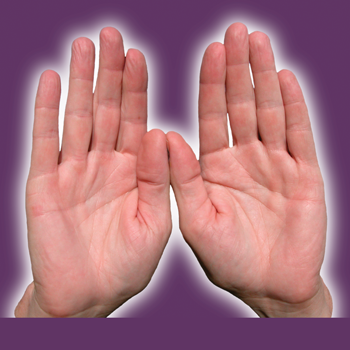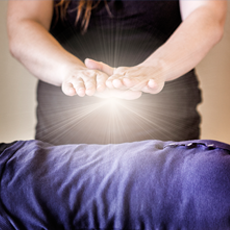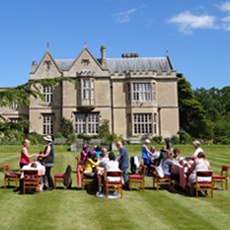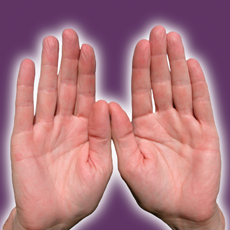by William Lee Rand
Serenity often comes from a sense of knowing that we are honoring the gifts we have been blessed with. When we feel inner stirrings to do more, to expand our abilities, so we can make the contribution we were brought to this life to make, we must then choose. Do we ignore this guidance, in the name of tradition, or do we change and grow? The search for serenity has brought many to study and practice Reiki. However, the more we work with Reiki, the more we are guided to let it develop our skill, out of this development comes the changing way of Reiki.
Reiki is a Japanese system of natural healing based on channeling healing energy through the hands. Reiki healing energy is a special kind of healing energy that has its own consciousness and does not need to be guided by the practitioner. Reiki simply guides itself by communicating with the clients higher self and using the information received to adjust itself for the specific needs of the client. Because of this, the practitioner does not have to decide what to do or how to do it, and simply allows the Reiki energy to flow through, trusting in its innate wisdom. Furthermore, one does not learn to channel Reiki energy in the same way other things are learned. The ability to channel Reiki is simply passed on to the Reiki student through the Reiki master during an attunement process. After that, the student is shown how to place the hands and how to allow the intelligence of Reiki to guide the practitioner in giving a treatment. This truly marvelous system of healing is so simple that virtually anyone can learn to do it.
The practice of Reiki has gone through a process of evolution since it was brought to the western world by Mrs. Takata in 1938. After World War II, Mrs. Takata was the only practicing Reiki master in the world. Therefore, anyone who wished to study Reiki, had just one teacher to study with. When she began training other Reiki masters in 1970, she charged $10,000 for the Reiki master training. Due to problems surrounding the war with Japan and the conditions of her Reiki training, she chose to teach in a very rigid way, discouraging her students from experimenting and strictly requiring them to practice exactly as she taught them. She explained that if they varied from the technique in anyway, they would not be doing Reiki. Innovation and the development of new techniques was discouraged.
Mrs. Takata was a very adept Reiki master who had a lot to offer her students. However, taking notes or the use of tape recorders was not allowed in Mrs. Takata's classes. She also taught her masters to teach the same way she taught and to require students to study with just one Reiki master. Her masters, not having any written material or notes to work from, and not wanting to make mistakes, tended to pass on a little less information than what they were given. As this process continued from teacher to student, Reiki began to lose vitality.
The rigidity, allegiance to one master and the high fees tended to keep the emphasis of Reiki more on a hierarchy whose purpose was to rigidly preserve a tradition rather than to openly develop one's ability to heal and help others. The beginning of Reiki in the western world may seem restrictive in some ways, but the important thing is that it did get started. We are grateful to Mrs. Takata and her Reiki masters for the sacrifices they have made and their dedication to preserving Reiki. This style of Reiki continues to be taught in many areas of the world and is appropriate for some people and provides an important aspect to the overall expression of this healing art.
Although its beginnings were somewhat stifling to the spirit of Reiki, the Reiki energy began to heal its own expression. As more people were trained and began using Reiki, the nature of the energy itself began to influence how it was practiced. Reiki energy, being very flexible and creative, treating each unique situation with a unique response and working freely with all other forms of healing, inspired those same qualities in its students and teachers. Many, trusting in their inner promptings, began to break away from the rigid way they had been taught and tried new things. Some teachers began training with more than one teacher and exchanging information among themselves. Lower, more reasonable fees were instituted. Others began experimenting and adding to their practice, knowledge and healing skills they had learned from other systems of healing or had acquired from inner guidance. By developing new Reiki techniques, depth was added to their understanding and they developed their own style thus improving the effectiveness of their healing abilities.
Through innovative, intuitive development, deeper levels of Reiki guidance were uncovered bringing to the surface the understanding that Reiki can guide your whole life, creating beauty, abundance and health on every level. When these teachers taught, they passed on their new information and skills to their students. Because they had the courage to follow their inner guidance, vitality has been added to the system of Reiki, which allows it to remain healthy, to grow and develop. In this way, the practice of Reiki is evolving as the Reiki energies heal and guide those who practice it.
The process of evolution that the system of Reiki healing has followed is similar to the system of martial arts training of the Japanese Samurai. According to the "Heiho Okugi Sho," a manual used by the Takeda Samurai, at the first or lowest level of training called Heino-Tsukai, the Samurai studies with just one teacher and practices only what is given to him. He also passes on to his students only what he was taught, adding nothing of his own experience. At this level of training, it was found that the system gradually declined over time due to a lack of vitality.
The highest level of training was called Heiho Sha. At this level, the Samurai studies deeply from many teachers, and experiments on his own to develop his technique to even greater levels of effectiveness. When he trains others, he passes on what he has learned including his personal additions. At this level, the system is filled with vitality and continues to develop over time. Because Reiki comes from Japan, perhaps the same spirit that guided the Samurai in the development of their system is now guiding the development of Reiki.
While the healing energy used by Reiki practitioners remains the same, it should be kept in mind that the experience and range of healing skills each has developed can be quite different. Some practitioners have remained with the beginning tradition as started by Mrs. Takata while others are of the more recent school where study with many teachers is emphasized and the development of personal style is present.
When choosing a Reiki healer or teacher, it is important to find out if they are part of a true Reiki lineage, leading back to Dr. Usui. Even more important is the extent of their training, how long have they been practicing, how much do they charge, and exactly what will you receive from them.
Ask to talk to some of their clients and students to find out what they received and if they are happy with it. The most important thing to depend on when choosing a practitioner or teacher is your own inner guidance. Do you feel comfortable with the person's energy, and do they have a true desire to help you?
As reality continues to unfold, created by the combined intention of the world mind reflecting on its own nature, it is fascinating to observe the many varieties of spiritual practice that are becoming available to the aspiring student. Let us be ever mindful of the increased freedom the changing nature of our choices brings to us and call on inner wisdom to guide us to ever deeper levels of joy and peace.







